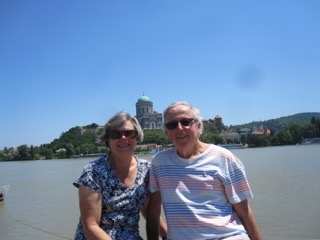Sunday 9th June. We walked to St Stephens Basilica – a mass was in progress but visitors allowed in. Then across the Chain Bridge with spans the Danube to the funicular on the Buda side that takes you up to the castle. 6euros for over 65’s. Decided to start with the museum – free for over 70’s. This is self guided so we started with the lower levels and worked our way up. In the lower chambers you see the excavations of storerooms, chapels, parts of towers, staircases and dungeons. The upper floors give more of the historical content of reigns of kings plus artefacts, china , paintings. It was a very impressive museum. We intended visiting the art gallery but decided we’d done enough for one day so walked along the foreshore to Margrit Bridge. It was here on the Pest side that last week, a river cruise ship and local boat collided with the cruise ship pushing the boat under water with many loss of life – South Koreans. Today the dredges were still there plus international news teams.We walked passed the Parliament building to the Bronze shoes, there to represent the Jews who were walked into the water and shot by the fascists during WW2. Dinner tonight at Vak Varju Hungarian Rest recommended by Marti at Trendy.Very busy, vibrant and popular place we made a booking.
Monday 10th June. It turned out to be Whit Monday holiday not only for museums but lots of other places we wanted to visit. The Market Hall was closed as was the Whale Building so we took No 2 tram along the river to Parliament House only to find all tours for the day in English were booked, and you can’t go in without a tour! Next plan was to take a train to the Park. The museums were closed normally on a Monday so the onlything to do was have such, enjoy the paddle boats on the lake and the serenity. Afternoon tea was at a Portuguese cafe with Portuguese tarts.
Tuesday11th June. Danube Bend Tour. Our pickup was over half an hour late. We were about to give up when a cab pulled up and asked if were waiting for a site seeing tour his friend will be here shortly. Sure enough he turned up a few mins later. Some major roads were closed due to the removal the sunken boat and traffic was very heavy. We knew that because our street was stop/start from 8.30. The bus was waiting for us and a few other late comers.Our English guide was Judit. First stop was Estzergom which used to be the Hungarian capital. Judith gave us a guided tour of the basilica – the largest in Hungary – with beautiful frescoes on the ceilings. A drive across the Danube into Slovakia (which used to be part of Hungary) to view the basilica from there.
Half an hour away was Visegrad with its castle perched on top of a rocky hill. The fortifications are mid 13th cent with a spectacular view across the Danube into Slovakia. We walked up to the top of the castle and managed to see some of the restored rooms in the time we had there. Such was in a local hotel where we had something quick so we could explore part of the town.
Next stop Szerlendre, a baroque town built as the gateway of the Danube Bend. It is an artists village with painters, ceramicists and other crafts. Again cobblestone, narrow streets. We visited Margit Kovacs ceramic museum. Shows an artist who lived in the village all her life but renowned throughout the world. She worked through the Art Nouveau period to the 1970’s. Her ceramics went around the world and she was visited by heads of state and royalty.
The hour long cruise down the Danube was tranquil and very pleasant. Dinner at small asian restaurant.
Wednesday 12th June. Today we visited the Hungarian National Museum. A museum of political history from 1100AD when Stephen 1 reigned. The exhibits proceeded through the centuries with a lot of information on WW1 & WW2 then the Hungarian Revolution and Russian occupation.
After lunch walked the nearby Central Market Hall a 19th century iron-frame construction, reopened in 1994 after renovation as a fresh food market and folk craft centre.
Later in the afternoon we took a walk to the Jewish Synagogue – the largest in Europe seating 3000 people. It was used by the Germans during WW2 as stables and communication centre. They took away many artifacts but left the building standing. A fascinating tour revealing the history of the area in troubled times.
The first photo is the Tree of Life in the Jewish Synagogue. The leaves have names of those Jews killed during WW2. 2nd on the Danube trip from Slovakian side looking towards the Basilica


